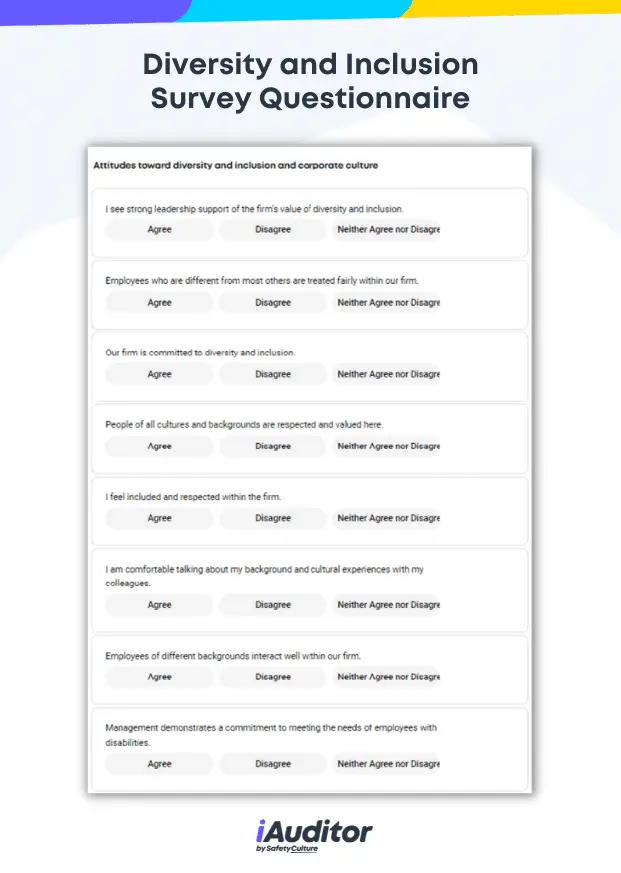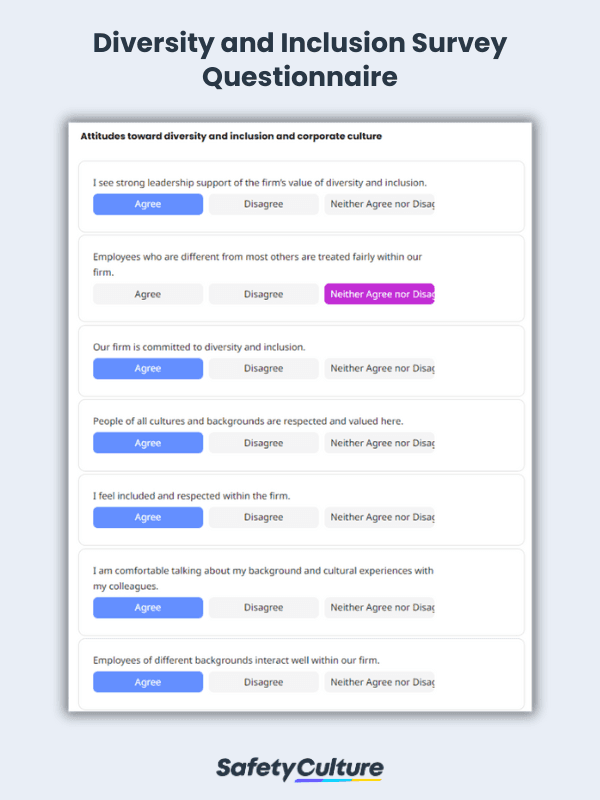What is a Diversity Survey?
A diversity survey is a tool used by organizations to measure and gather information about diversity in the workplace. The questionnaire includes questions about the level of satisfaction or happiness of an individual regarding diversity and its effects within the organization. Promoting workplace diversity helps improve overall productivity because it acknowledges the different characteristics and experiences of individuals in the company.
An organization or company with high diversity is more likely to perform better financially and culturally. Diverse teams outperform non-diverse ones since there are more opportunities to learn from individuals with different characteristics and experiences. The positive effects of diversity, such as an increase in productivity and creativity, among others, are prevalent, and companies are striving for it. Diversity is a serious issue, and companies should have a genuine interest in diversity since forced diversity training is known to increase prejudice in upper management. Diversity starts when people in the workplace talk and give feedback to their leaders.
4 Types of Diversity in the Workplace
Learn the different dimensions of diversity to better understand the people in your organization and their needs. Awareness of diversity types will be beneficial for creating diversity and inclusivity surveys. The types are:
1. Internal Diversity
Internal diversity refers to traits that are inherent to a person and can rarely change or be controlled. Examples of this type include race, national origin, ethnicity, gender, sexuality, sexual appearance, and physical and mental ability. When individuals discover a gender or sexuality they feel more comfortable in or identify as, this is considered an internal change. It’s considered as such because the change was a result of self-discovery and not influenced by external factors.
2. External Diversity
External diversity is the dimension that relates to the person’s acquired characteristics. Unlike the inherent traits of internal diversity, this is Influenced and controlled by the person on their own or developed with the assistance of other people. The characteristics under this category include interests, education, appearance, citizenship, geographic location, and religion. Family status, relationships, and socioeconomic status are also considered external factors.
3. Organizational Workplace Diversity
Organizational workplace diversity refers to the factors in a work environment that affect a person. Promoting diversity in the workplace comes with inherent benefits, including an increase in performance and creativity. This type of diversity covers job function, management status, work location, and seniority or tenure.
4. Worldviews
World views in relation to diversity refers to what individuals have seen and experienced that have affected their lives and how they live it. A person gains these experiences through interaction with and immersion in different cultures and beliefs. This category includes cultural events, politics, knowledge of history, and other factors that may impact an individual’s worldview.
How to Promote Diversity and Inclusivity in the Workplace
Achieving diversity in the workplace can seem like a complicated process, but with proper planning and open communication, this won’t be the case. Employees only want to be treated fairly and be recognized for their accomplishments, and promoting diversity will help achieve this and highlight each individual’s unique traits and contributions in the process. Here are simple reminders on how to promote diversity and inclusion:
- Expand your talent pool by hiring without prejudice
- Acknowledge and break down biases
- Take action and give credibility to the underrepresented
- Create diverse and inclusive focus teams
- Respect all your coworkers regardless of race, sexuality, seniority, and social class
- Celebrate diversity by remembering important dates and events, such as Ramadan for Muslim employees and Pride month for those who identify as part of the LGBTQ community
- Provide food and beverage options that consider dietary restrictions and preferences of employees
- Let employees’ voices be heard and routinely ask for feedback through diversity surveys
Workplace Diversity Questionnaire Example
Below are some example questions about workplace diversity that are answered with the responses: Agree, Disagree, and Neither Agree nor Disagree.
Attitudes toward diversity and inclusion and corporate culture
- I see strong leadership support of the firm’s value of diversity and inclusion
- Employees who are different from most others are treated fairly within our firm
- Our firm is committed to diversity and inclusion
- People of all cultures and backgrounds are respected and valued here
- I feel included and respected within the firm
- I am comfortable talking about my background and cultural experiences with my colleagues
- Employees of different backgrounds interact well within our firm.
- Management demonstrates a commitment to meeting the needs of employees with disabilities
- Racial, ethnic, and gender-based jokes are not tolerated at this firm
- This firm provides an environment for the free and open expression of ideas, opinions and beliefs.
Discrimination and harassment
- If I had a concern about harassment or discrimination, I know where and how to report that concern
- The firm’s policies and procedures discourage discrimination
- I believe this firm will take appropriate action in response to incidents of discrimination
Hiring and recruitment
- There is cultural diversity among the people a job candidate will meet/see on his/her first visit to the firm
- Within the firm, everyone has access to equal employment opportunities regardless of their difference
Your immediate supervisor
- My supervisor demonstrates commitment to and support of diversity
- My supervisor handles diversity matters appropriately
Diversity training program
- This firm has done a good job providing training programs that promote diversity and inclusion.
- The firm has done a good job providing training programs that promote understanding and mitigation of unconscious bias.AgreeDisagreeNeither Agree nor Disagree
Belonging
- Belonging is a sense of fitting in or feeling like you are an important member of a group.
- In my organization, I can be successful as my authentic self.


